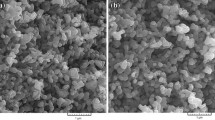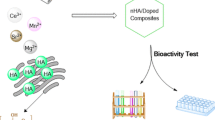Abstract
Bioactivity and osteoblastic growth of hydroxyapatite (HA)-incorporated silica aerogels (SA) (HAESA) with different ratio of HA/SiO2 (0.1, 0.5, 1.0, and 1.3 HA/SiO2) were investigated. Bioactivity of HAESA was studied by immersing all samples in simulated body fluids (SBF) for 7 and 14 days. The recovered samples were then characterised using Fourier transform infrared spectroscopy, X-ray diffraction, field emission scanning electron microscopy combined with energy dispersive X-ray analyser (FESEM–EDX) and the analysis of phosphate loss in the solution. These samples were also investigated for their effect on cell viability and proliferation abilities against normal human osteoblast cells in vitro after 24 and 48 h of exposure times. The HA/SiO2 ratio affected its bioactivity in which the bioactivity increased to 0.5 (HAESA-0.5) and declined at higher ratios (1.0 and 1.3). A similar trend was observed for cell viability and proliferation assays. HAESA-0.5 (HA/SiO2 ratio of 0.5), which possesses the optimal characteristics of SA and HA, resulted in the highest osteoblastic growth due to the synergistic effects between SA and HA. Thus, HAESA-0.5 could be an alternative biomaterial compared to silica- and HA-based biomaterials for bone implant application due to its higher bioactivity in SBF with the improved performance of osteoblast growth.
Hydroxyapatite-incorporated silica aerogel with different weight ratio of HA/SiO2 (HAESA) was studied for their bioactivity in simulated body fluid and in vitro osteoblastic growth.

Highlights
-
Hydroxyapatite-incorporated silica aerogels (HAESA) has higher bioactivity than silica aerogel.
-
HAESA has higher bioactivity than free hydroxyapatite.
-
HAESA increases cell viability and proliferation of normal human osteoblast cells.
-
HAESA at 0.5 weight ratio has the highest bioactivity and biocompatibility.








Similar content being viewed by others
References
Hoornaert A, Layrolle P (2020) Bone regenerative issues related to bone grafting biomaterials. In: Dental implants and bone grafts. Woodhead Publishing, UK, pp 207–215
Williams DF (2019) Biomaterials for sustainable tissue engineering. Front Bioeng Biotech 7:127
Ananth KP, Nathanael AJ, Jose SP, Oh TH, Mangalaraj D (2016) A novel silica nanotube reinforced ionic incorporated hydroxyapatite composite coating on polypyrrole coated 316L SS for implant application. Mater Sci Eng C 59:1110–1124
Tavafoghi M, Kinsella JM, Gamys CG, Gosselin M, Zhao YF (2018) Silicon-doped hydroxyapatite prepared by a thermal technique for hard tissue engineering applications. Ceram Int 44(15):17612–17622
Preethanath RS, Rajesh P, Varma H, Anil S, Jansen JA, van den Beucken JJ (2016) Combined treatment effects using bioactive‐coated implants and ceramic granulate in a rabbit femoral condyle model. Clin Implant Dent Relat Res 18(4):666–677
Sani NS, Malek NANN, Jemon K, Kadir MRA, Hamdan H (2019) Preparation and characterization of hydroxyapatite incorporated silica aerogel and its effect on normal human dermal fibroblast cells. J Sol-Gel Sci Technol 90(2):422–433
Győri E, Fábián I, Lázár I (2017) Effect of the chemical composition of simulated body fluids on aerogel-based bioactive composites. J Compos Sci 1(2):15
Ksouri D, Khireddine H, Aksas A, Valente T, Bir F, Slimani N, Cabal B, Torrecillas R, Santos JD (2018) Synthesis of ternary bioactive glass derived aerogel and xerogel: study of their structure and bioactivity. Nova Biotechnol et Chim 17(2):150–159
Martins M, Barros AA, Quraishi S, Gurikov P, Raman SP, Smirnova I, Duarte ARC, Reis RL (2015) Preparation of macroporous alginate-based aerogels for biomedical applications. J Supercrit Fluids 106:152–159
Maleki H (2016) Recent advances in aerogels for environmental remediation applications: a review. Chem Eng J 300:98–118
Sani NS, Malek NANN, Jemon K, Kadir MRA, Hamdan H (2017) Effect of mass concentration on bioactivity and cell viability of calcined silica aerogel synthesized from rice husk ash as silica source. J Sol-Gel Sci Technol 82(1):120–132
Stergar J, Maver U (2016) Review of aerogel-based materials in biomedical applications. J Sol-Gel Sci Technol 77(3):738–752
Dey S, Das M, Balla VK (2014) Effect of hydroxyapatite particle size, morphology and crystallinity on proliferation of colon cancer HCT116 cells. Mater Sci Eng C 39:336–339
Zeng H, Yang H, Liu X, Shi D, Cao B, Du C, Ouyang J, Yu L, Wang Y, Liao H (2014) In vitro effects of differentially shaped hydroxyapatite microparticles on RAW264. 7 cell responses. RSC Adv 4(54):28615–28622
Wang X, Ben Ahmed N, S Alvarez G, Tuttolomondo MV, Hélary C, F Desimone M, Coradin T (2015) Sol-gel encapsulation of biomolecules and cells for medicinal applications. Curr Top Med Chem 15(3):223–244
Rodriguez-Lorenzo LM, Gross KA (2003) Encapsulation of apatite particles for improvement in bone regeneration. J Mater Sci Mater Med 14(11):939–943
Rismanchian M, Khodaeian N, Bahramian L, Fathi M, Sadeghi-Aliabadi H (2013) In-vitro comparison of cytotoxicity of two bioactive glasses in micropowder and nanopowder forms. Iran J Pharm Res 12(3):437
Salinas AJ, Vallet-Regí M (2013) Bioactive ceramics: from bone grafts to tissue engineering. RSC Adv 3(28):11116–11131
Osorio DA, Lee BE, Kwiecien JM, Wang X, Shahid I, Hurley AL, Cranston ED, Grandfield K (2019) Cross-linked cellulose nanocrystal aerogels as viable bone tissue scaffolds. Acta Biomater 87:152–165
Zadpoor AA (2014) Relationship between in vitro apatite-forming ability measured using simulated body fluid and in vivo bioactivity of biomaterials. Mater Sci Eng C 35:134–143
Drouet C (2013) Apatite formation: why it may not work as planned, and how to conclusively identify apatite compounds. BioMed Res Int 2013:490946
Henstock JR, Canham LT, Anderson SI (2015) Silicon: the evolution of its use in biomaterials. Acta Biomater 11:17–26
Venkatraman SK, Swamiappan S (2020) Review on calcium and magnesium based silicates for bone tissue engineering applications. J Biomed Mater Res A 108:1546–1562
Sánchez‐Fernández MJ, Hammoudeh H, Félix Lanao RP, van Erk M, van Hest JC, Leeuwenburgh SC (2019) Bone‐adhesive materials: clinical requirements, mechanisms of action, and future perspective. Adv Mater Interfaces 6(4):1802021
Lu X, Leng Y (2005) Theoretical analysis of calcium phosphate precipitation in simulated body fluid. Biomater 26(10):1097–1108
Xian W (2009) A laboratory course in biomaterials. CRC Press, UK
Declercq H, Van den Vreken N, De Maeyer E, Verbeeck R, Schacht E, De Ridder L, Cornelissen M (2004) Isolation, proliferation and differentiation of osteoblastic cells to study cell/biomaterial interactions: comparison of different isolation techniques and source. Biomater 25(5):757–768
Padial-Molina M, Galindo-Moreno P, Fernández-Barbero JE, O’Valle F, Jódar-Reyes AB, Ortega-Vinuesa JL, Ramón-Torregrosa PJ (2011) Role of wettability and nanoroughness on interactions between osteoblast and modified silicon surfaces. Acta Biomater 7(2):771–778
Bellamakondi PK, Godavarthi A, Ibrahim M, Kulkarni S, Naik RM, Maradam S (2014) In vitro cytotoxicity of caralluma species by MTT and trypan blue dye exclusion. Asian J Pharm Clin Res 7(2):17–19
Kim EJ, Bu SY, Sung MK, Choi MK (2013) Effects of silicon on osteoblast activity and bone mineralization of MC3T3-E1 cells. Biol Trace Elem Res 152(1):105–112
Shie MY, Ding SJ, Chang HC (2011) The role of silicon in osteoblast-like cell proliferation and apoptosis. Acta Biomater 7(6):2604–2614
Kolmas J, Krukowski S, Laskus A, Jurkitewicz M (2016) Synthetic hydroxyapatite in pharmaceutical applications. Ceram Int 42(2):2472–2487
Rao CY, Sun XY, Ouyang JM (2019) Effects of physical properties of nano-sized hydroxyapatite crystals on cellular toxicity in renal epithelial cells. Mater Sci Eng C 103:109807
Sani S, Muhid MNM, Hamdan H (2011) Design, synthesis and activity study of tyrosinase encapsulated silica aerogel (TESA) biosensor for phenol removal in aqueous solution. J Sol-Gel Sci Technol 59(1):7–18
Acknowledgements
The authors would like to thank the Ministry of Education, Malaysia and Universiti Teknologi Malaysia (UTM) for financially supporting this research under the Fundamental Research Grant Scheme (FRGS, Vot No: 4F514).
Author information
Authors and Affiliations
Corresponding author
Ethics declarations
Conflict of interest
The authors declare that they have no conflict of interest.
Additional information
Publisher’s note Springer Nature remains neutral with regard to jurisdictional claims in published maps and institutional affiliations.
Rights and permissions
About this article
Cite this article
Sani, N.S., Malek, N.A.N.N., Jemon, K. et al. In vitro bioactivity and osteoblast cell viability studies of hydroxyapatite-incorporated silica aerogel. J Sol-Gel Sci Technol 96, 166–177 (2020). https://doi.org/10.1007/s10971-020-05386-w
Received:
Accepted:
Published:
Issue Date:
DOI: https://doi.org/10.1007/s10971-020-05386-w




